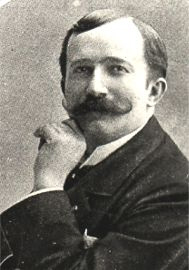
James Henry Fillmore Jr., known as Henry (December 3, 1881 – December 7, 1956) was an American musician, composer, publisher, and bandleader, best known for his many marches and screamers. Fillmore was born into a family of composers and publishers of religious music on December 3, 1881, in Cincinnati, Ohio, as the eldest of five children. In his youth he mastered piano, guitar, violin, flute, and slide trombone. He kept his trombone activities a secret at first, as his circumspect religious father James Henry Fillmore (1849–1936)—a composer of gospel songs, often in collaboration with Jessie Brown Pounds—believed it an uncouth and sinful instrument. Henry’s mother secretly bought a used trombone for him and obscured, from Henry’s father, the son’s learning to play the instrument. Henry, whose uncle Frederick Augustus Fillmore (1856–1925) was also a tune-composer for gospel songs, was a singer for his church as a boy.
However, a somewhat incorrigible youth, the young Fillmore was bored with church music. He preferred more exciting music such as that used in circuses. In fact, he ran off with circuses at least three times. This caused no small amount of consternation in the family, which had a dignified English-American bearing (he was a second cousin, twice removed, of President Millard B. Fillmore), so he received much of his education in a military school. He began composing at 18, with his first published march “Hingham”, named after a line of brass instruments. Graduating from the Miami Military Institute in 1901, Fillmore entered the Cincinnati Conservatory of Music. Frustrated at being unable to influence the Fillmore Brothers to branch into the publication of band music, he left home after graduating, married his secret sweetheart Mabel May Jones, an exotic vaudeville dancer, in Saint Louis, MO, and joined the Lemon Brothers circus as a trombone player. He traveled the United States as a circus bandmaster with his wife for one season.
In the 1920s Fillmore was back in Cincinnati and the family publishing company, but it was several years before they accepted Mabel. Gradually, Henry persuaded his father and uncles to publish more band music. The firm eventually became a leading band house, primarily because the music of Henry Fillmore and his seven aliases had become very popular. Another factor was his expertise as an arranger and editor. Meanwhile, he was heavily involved with bands in the Cincinnati area. Under his leadership, the Syrian Temple Shriners Band became America’s finest fraternal band. Industrialist Powell Crosley enticed him to organize a professional band, and it, too, achieved widespread fame through broadcasts over the powerful radio station WLW. One novel feature of the programs was Henry’s exceptional dog, Mike the “radio hound,” who barked at predetermined spots in the music.
As Henry’s composing career flourished, rivals claimed his success was because of his name, not his music’s merit. To silence them, he began publishing under pseudonyms, including the humourous “Gus Beans.” Henry’s music was now being played by bands throughout North America and abroad, and his intense schedule as composer, arranger, music editor, and conductor began to take its toll. In his late fifties, he developed a serious heart problem. Doctors told him his life expectancy would be less than one year unless he retired. They also suggested that he move to a warmer climate. So, in 1938 Fillmore retired to Miami, Florida. He went on, however, to prove the physicians wrong, spending much of his time and energy with area schools and the University of Miami music department. Fillmore kept an active schedule rehearsing high school bands in Florida and composing marches. Henry Fillmore Band Hall, the rehearsal hall for many of the University of Miami’s performing groups, acquired its name as a tribute to Fillmore’s work in the band genre. His march Orange Bowl was written for Miami’s Band of the Hour. Uncle Henry, as Fillmore was affectionately known to the members of the Band of the Hour, also wrote the University of Miami’s current official fight song – “Miami U How-De-Doo.” His arrangement of the ‘The Star-Spangled Banner’ is the traditional arrangement performed by the Florida State University Marching Chiefs. His march Men of Florida was composed for the bands at the University of Florida.
Fillmore wrote over 250 pieces and arranged orchestrations for hundreds more. He published under a variety of pseudonyms, including Gus Beans, Harold Bennett, Ray Hall, Harry Hartley, Al Hayes, and Henrietta Moore. Only the name Will Huff caused any issues, as another Will Huff composed marches and resided in Fillmore’s state. While best known for march music and screamers, he also wrote waltzes, foxtrots, hymns, novelty numbers, and overtures. In addition, Fillmore gained fame as the “Father of the Trombone Smear,” writing a series of 15 novelty tunes featuring trombone smears called “The Trombone Family.” A number of these have a strong ragtime influence. The tunes have subtitles printed on the parts, some of which reflect social and racial realities of the time. He was given an Honorary Doctorate of Music by the University of Miami in 1956 in recognition of his career. Fillmore lived out the rest of his days in South Florida. Perhaps no other individual has had his level of influence on the music of the private University of Miami and the public University of Florida and Florida State University. He died peacefully in his sleep on December 7, 1956.
The following works by Henry Fillmore are contained in my collection:
Americans We.
The Circus Bee.
The Footlifter.
His Excellency (March).
The Klaxon.
Men of Ohio.
Rolling Thunder.








